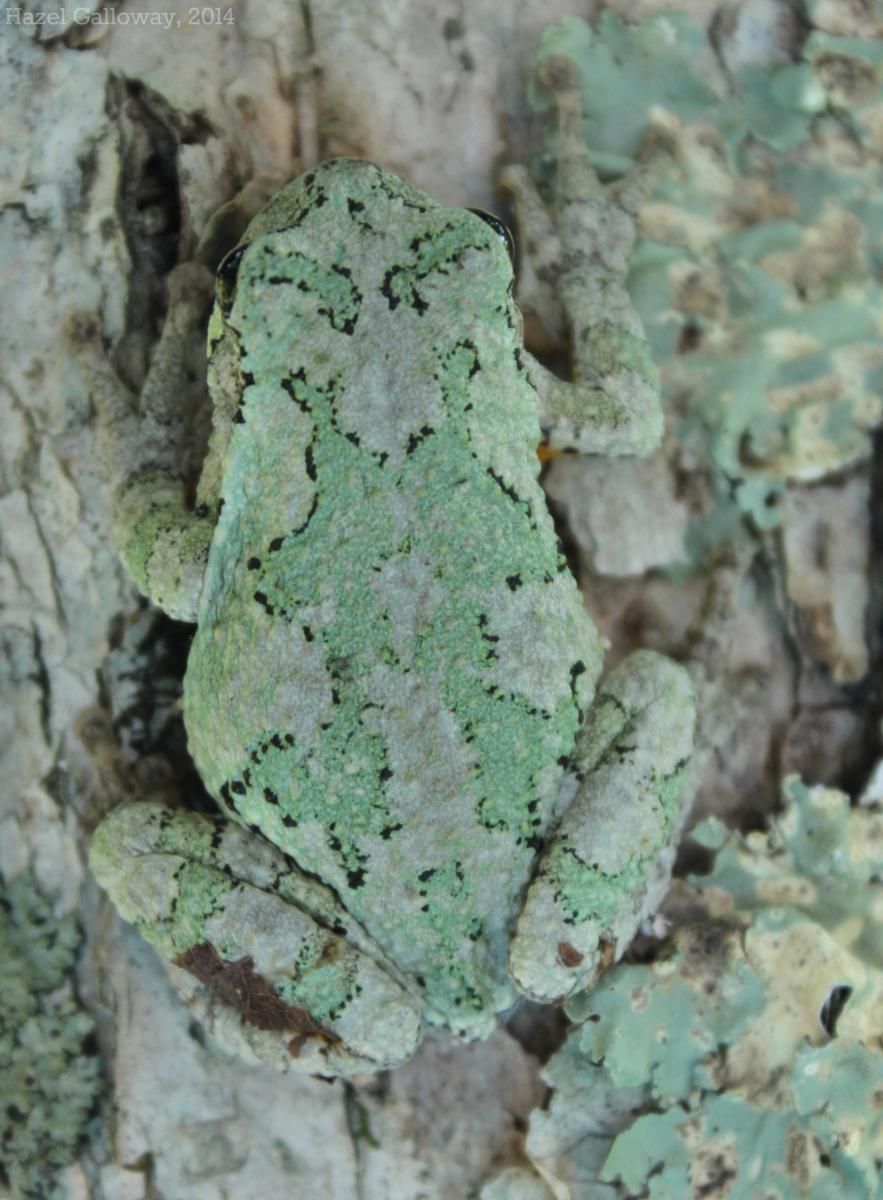In the 1930s, researchers studying grey treefrogs noticed the existence of two different types of calls distributed along a longitudinal cline. Faster, higher-pitched, harsher-sounding calls were produced in the southern part of the range, while slower, more mellow-sounding calls were more prevalent in the north. Thirty years later, it was found that female treefrogs of both call types demonstrated discrimination between calls. As those present for Alex Baugh’s seminar concerning the extraordinarily discriminatory powers of female frogs might guess, this difference creates a nearly impenetrable mating barrier between what are now recognized as two distinct species of treefrog—eastern grey treefrogs (H. versicolor) and Cope’s grey treefrogs (H. chrysoscelis) Although the two species are absolutely indistinguishable in the field, work done in 1970 demonstrated that H. chrysoscelis is a diploid species while H. versicolor, curiously enough, is tetraploid.
Both physically identical species typically measure 3.2-5.1 cm in length. They have a cryptic, rough grey skin, which may vary in color towards brown, green, or pearl-grey depending upon the season and humidity. Grey treefrogs have white patches under their eyes and a white underside, accented with dramatic yellow-orange on the ventral side of their rear legs and their groin area.
H. versicolor emerges from hibernation in the early spring, but must build up its energy reserves before beginning to call. The choruses usually begin in late April or early May when the evening air temperature reaches 15°C (59°F). Female choice determines mating, as they tend to approach males with longer and more frequent calls. So-called “satellite males,” young or otherwise disadvantaged individuals, may lay in wait near a prodigious caller until he moves away, and they move in to intercept any approaching females. Most males, however, aggressively defend territories in trees and vegetation near or overhanging the water. A successful approach results in amplexus, where the male clings firmly to the female as she deposits around 1,800 eggs in a large egg mass. The egg mass is externally fertilized by the male, shortly after which it divides into small clusters of 10-40 eggs that attach loosely to aquatic vegetation or other structures in the pond.

After hatching in 3-7 days, it takes 6-8 weeks for the tadpoles to metamorphose into tiny frogs, just 1.5 cm in length. The young that survive until November must face their first winter, a challenge the species confronts wholeheartedly. Grey treefrogs enter underground hibernacula where they spend the winter; one individual was found several feet underground among the roots of an apple tree. In frigid temperatures, the frogs produce glycerol as a cryoprotectant, lowering the freezing point of the body’s fluids. When freezing is inescapable, some species of tree frogs have been known to utilize special “ice-nucleating agents” to control the formation of ice crystals such that they do not damage the cells. While this has not been documented in H. versicolor, 80% of their body does often freeze during hibernation, causing their eyes to become opaque and breathing and heartbeat to be suspended. In this state, they can survive for 5-7 days at -6°C (21°F).

Like all members of their genus, H. versicolor possesses specialized toe pads responsible for their impressive climbing powers. A combination of mucous glands and surface moisture creates enough surface tension to support their weight when climbing surfaces from tree bark to the glass terrarium walls.
This male was captured calling near the pond by the field herpetology class. Although there is no sexual dimorphism, only males produce calls. This increases their chances of predation, resulting in a female-biased population.
Hazel Galloway
Sources:
- A Field Guide to Reptiles and Amphibians: Eastern and Central North America. 3rd Edition. Boston: Houghton Mifflin Company,1998.
- http://animaldiversity.ummz.umich.edu/accounts/Hyla_versicolor/
- http://www.amphibiaweb.org/cgi/amphib_query?where-genus=Hyla&where-species=versicolor
- http://www.newscientist.com/article/dn20260-zoologger-cryofrog-survives-deep-freeze.html#.U76NCvldWoM
Thanks to Caitlin Fisher-Reid for the calling photo, taken at night when the treefrog was captured!
